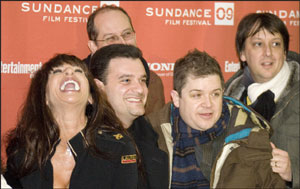Sundance Festival offers opportunities
January in Park City, Utah, features the Sundance Film Festival, which is celebrating its 25th year. It is a cultural icon, especially for college journalists and filmmakers.
The Festival began in Salt Lake City in 1978 as the Utah/U.S. Film Festival in an effort to attract more filmmakers to Utah.

This archived article was written by: Kris Kohler
January in Park City, Utah, features the Sundance Film Festival, which is celebrating its 25th year. It is a cultural icon, especially for college journalists and filmmakers.
The Festival began in Salt Lake City in 1978 as the Utah/U.S. Film Festival in an effort to attract more filmmakers to Utah.
Founded by Sterling Van Wagenen and John Earle with Chairperson Robert Redford, the goal of the festival was to showcase what the potential of independent film could be. At the time, the main focus of the event was to present a series of retrospective films and filmmaker panel discussions; however it also included a small program of films made outside the Hollywood system, known as independent films.
Management of the Festival was taken over by the Sundance Institute, a non-profit organization, in 1985. In 1991 the Festival was officially renamed the Sundance Film Festival, after Redford’s character The Sundance Kid from the movie Butch Cassidy and the Sundance Kid.
The Festival has changed over the decades from a low-profile venue for small-budget, independent creators from outside the Hollywood system to a media extravaganza for Hollywood celebrity actors, directors from studios that are subsidiaries of the major studios, paparazzi and luxury-goods company sponsors giving gifts to the attendees.
Over the following years, several factors helped propel the growth of Utah/U.S. Film Festival. First was the involvement of actor Robert Redford. Redford, a Utah resident, became the festival’s inaugural chairman and having his name associated with Sundance gave the festival great attention, according to the Sundance website.
Second, the festival moved from September to January. The move from late summer to mid-winter was reportedly done on the advice of Hollywood director Sydney Pollack, who suggested that running a film festival in a ski resort during winter would draw more attention from Hollywood.
The festival is an opportunity for communication students to get an idea how film festivals work and provides crucial networking opportunities in their field of interest.
The human experience provided at the festival is limited only by an individual’s desire to expand their personal network with people that are already working in the film and public relations fields and can prove to be as inspirational; and educational as any class that one can take spotlighting their own individual discipline.
Stopping by the festival the opening weekend, I hoped to see a premier that I was interested in. What I ended up experiencing was something much more valuable and exciting than just watching a movie.
I ended up meeting several producers and writers that provided exclusive interviews in the future. I got exclusive interviews and photo opportunities from the entire cast and crew of the feature “The Big Fan,” which I hope to publish nationally.
Anyone interested in expanding their network and learning valuable insights in the film industry should purchase tickets to the event ahead of time for availability and convenience. Festival goers who cannot obtain tickets in advance to see the films may buy same-day tickets at the box office, or line up for wait list tickets at a theater two hours before a scheduled showing. Wait-list tickets are an excellent way to get into the screenings that appear to be sold out, for those who are prepared to wait.
Anyone in the communications, psychology or theatre fields should make it a point to attend. I cannot emphasize how valuable my experience was. I can only imagine how good it could have been with a little planning. I went on a whim and came out with a whole new outlook on the event.




